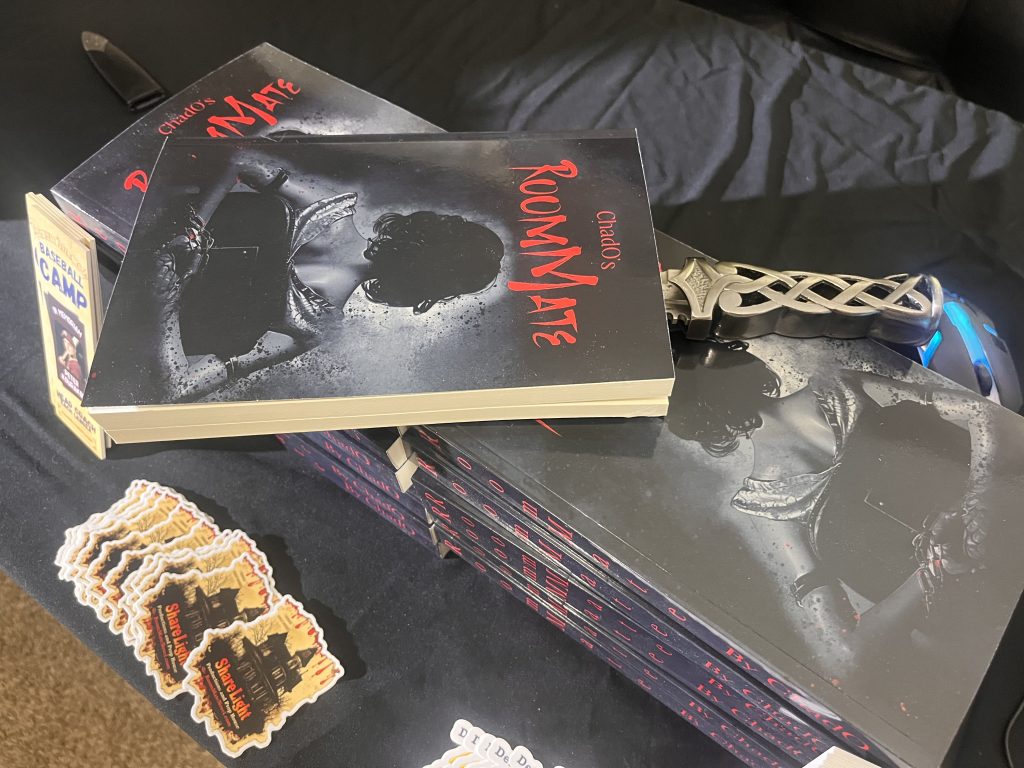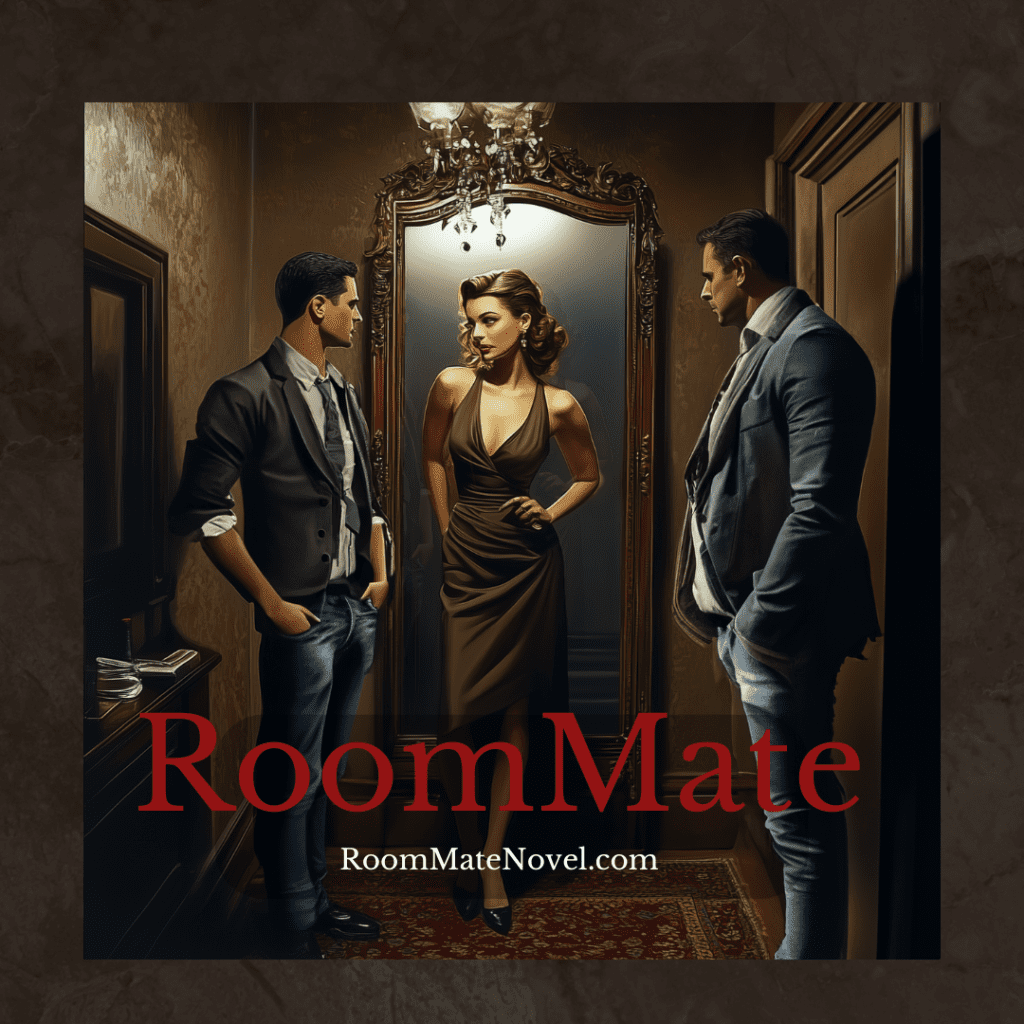
Psychological thriller
Available Now!
Copyright © Slap Knee Media | All Right Reserved.
Psychological thriller
Copyright © Slap Knee Media | All Right Reserved.

In the beginning, RoomMate was a screenplay centered around a male protagonist, a script that felt like it was lacking something indefinable but essential. It was ChadO’s decision to reimagine the story with Charlet as the lead that breathed new life into the narrative. The motivations behind this shift were deeply rooted in the desire to explore the complexities of a female protagonist in the horror/thriller genre, a landscape often dominated by male narratives. By placing Charlet at the forefront, the story transcended its initial boundaries, morphing into a psychological labyrinth where every twist and turn revealed something darker, something more human.
Charlet is not your typical movie producer. She’s a deranged genius with OCD, a woman whose traumatic past casts long shadows over her present. ChadO’s book digs into her psyche, painting her not merely as a villain but as a deeply scarred individual. Her compulsions, her obsessions, they’re not just quirks; they’re manifestations of a mind teetering on the edge. Charlet’s gender adds an additional layer of complexity—it challenges the stereotypes of female characters in horror, making her a figure of both terror and empathy. Her journey is a descent into madness, a reflection of the darkness that can lurk within us all.
In a unique twist, ChadO decided to immortalize his friends by transforming them into characters within RoomMate. These weren’t just random insertions; each fictionalized persona carried the essence of their real-life counterparts. Yet, in the novel’s dark, twisted world, these traits were shifted, creating a chilling blend of reality and fiction. This approach added a deeply personal touch to the story, making it not only a work of imagination but a macabre tribute to those who supported its creation.
The real-life inspirations for ChadO’s characters became something far more sinister on the page—psychopathic killers and tragic victims. While influenced by actual personalities, the behaviors and actions of these characters were entirely imagined, a creative leap that allowed ChadO to explore the darkest corners of the human psyche. This stark contrast between reality and fiction heightened the sense of foreboding, making readers question the thin line between what is real and what is imagined.
Other central characters evolved significantly from the screenplay to the novel, their interactions with Charlet deepening the horror elements. The novel format allowed ChadO to flesh out these characters, giving them backstories and internal monologues that added layers of complexity and tension. Each interaction with Charlet was a careful scene creation, a push and pull that exposed the raw, unfiltered emotions driving the narrative.
Transitioning from script to novel opened up new dimensions for character development. The novel allowed ChadO to plummet into the internal thoughts and backstories of his characters, enriching the narrative with a psychological depth that was previously unattainable. This expansion made the characters more relatable, their fears and motivations more palpable, and the horror more intimate.
The characters in RoomMate were inspired by a blend of ChadO’s life experiences and pure imagination. By incorporating traits from his friends, ChadO added a layer of authenticity and intensity to the characters, making their struggles and descent into madness feel all the more real. This process of fictionalization not only honored his friends but also breathed life into a world that is as haunting as it is compelling.
The evolution of the characters in RoomMate transformed a simple screenplay into an intense psychological thriller. By scratching deep into their psyches, ChadO crafted a narrative that is as disturbing as it is captivating. These complex characters drive the story forward, their interactions and internal struggles creating a tension that keeps readers on the edge of their seats. For those who crave a dark, introspective journey into the human mind, pre-ordering the novel promises an exclusive look into a world where every shadow hides a secret and every character has a story worth uncovering.
In the original screenplay for RoomMate, the story was quite different. It was initially written with a male lead in mind—specifically, actor Jason Mewes, who expressed interest in exploring a darker, more sinister role. The character, Gerald, was crafted as a calm, controlled, and mysterious figure. His quiet demeanor masked a darker, tortured soul, shaped by a past full of sadistic abuse. Gerald was the kind of character who held his cards close to his chest, building tension through subtlety and intrigue.
The novel, however, features Charlet, a very different kind of antagonist. While both Gerald and Charlet share the same tragic backstory, growing up in sadistic environments filled with psychological and physical trauma, Charlet is anything but subtle. She is crazed, impatient, and explosive—her anger and madness are constantly on display. Charlet’s story doesn’t hold back. It’s raw, visceral, and unforgiving, designed to confront readers with the harsh realities of her world.
Unlike the screenplay, which kept Gerald’s internal turmoil beneath the surface, the novel fully explores Charlet’s twisted psyche. Her journey into darkness is intense and unfiltered, making RoomMate not for the faint of heart. If you’re easily triggered by themes of violence and psychological abuse, Charlet’s story will push your limits—there’s no holding back in the novel version.
But the evolution from Gerald to Charlet represents more than just a gender shift. It’s a deep dive into the human capacity for violence and the consequences of unchecked trauma. Charlet’s story is more brutal, and while Gerald’s calm exterior allowed for tension to build slowly, Charlet’s intensity makes the novel a relentless ride into madness.
For those who have followed RoomMate from its beginnings, the novel version offers a whole new layer of terror. And if you’re curious about how the story originally unfolded, the pre-orders come with a special bonus—a PDF of the original screenplay written for Jason Mewes. It’s a fascinating look at how RoomMate evolved, from Gerald’s controlled menace to Charlet’s explosive, psychotic fury.
The evolution of RoomMate is a testament to how stories change with time, but the core remains the same—a journey into the dark, twisted side of the human experience. Whether you’re drawn to the quiet menace of Gerald or the chaotic intensity of Charlet, one thing is for sure: RoomMate is not for the easily disturbed.
Follow RoomMate on Facebook or Instagram for the latest updates!
Reserve your copy of “RoomMate” now and be among the first to experience Charlet’s nightmarish secrets. Order Now!
Meet ChadO, the seriously crazed mind behind “RoomMate.” He’s an optioned Hollywood screenwriter, entrepreneur, and a comedian who revels in psychopathic humor.
Trigger Warnings: This book is packed with unimaginable horror and trauma. If you’re squeamish, turn back now.
LIMITED TIME OFFER:
Order your signed copy of Roommate Novel today and receive unique stickers, bookmarks, and the original screenplay.
Get your signed copy of Roommate Novel today and receive bonus gifts: stickers, bookmarks, and the original screenplay. Buy direct now!